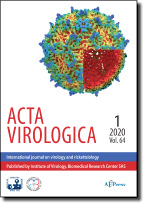Journal info
|
||
Select Journal
Journals
Bratislava Medical Journal Ekologia - Ecology Endocrine Regulations General Physiology and Biophysics Neoplasma Acta Virologica Current articles 2023 2022 2021 2020 2019 2018 2017 2016 2015 2014 2013 2012 2011 2010 2009 2008 2007 2006 2005 2004 2003 Studia Psychologica Cardiology Letters Psychológia a patopsych. dieťaťa Kovove Materialy-Metallic Materials Slovenská hudba 2025Webshop Cart
Your Cart is currently empty.
Info: Your browser does not accept cookies. To put products into your cart and purchase them you need to enable cookies.
Acta Virologica Vol.60, No.4, p.372-378, 2016 |
||
| Title: Mouse tetherin enhances moloney murine leukemia virus-induced syncytium formation | ||
| Author: H. S. KIM, S. Y. HAN, Y. T. JUNG | ||
| Abstract: Tetherin (also referred to as BST-2 or CD317) is an antiviral cellular restriction factor that inhibits the release of many enveloped viruses. It is a 30–36 kDa type II transmembrane protein, expression of which is induced by type I interferon. Mouse tetherin inhibits nascent cell-free particle release. However, it is unclear whether mouse tetherin restricts cell-to-cell spread of moloney murine leukemia virus (Mo-MLV) or whether is the mouse tetherin involved in syncytium formation. To examine cell-to-cell spread and syncytium formation of Mo-MLV in the presence or absence of mouse tetherin, R peptide (the cytoplasmic tail of the transmembrane protein (TM); 16 amino acids) truncated Env expressing vector was constructed. It contained enhanced green fluorescent protein (EGFP) in the proline rich region (PRR) of Env. This R(-)Env full-length molecular clone could rule out virus-cell transmission due to the slightly reduced R(-)Env protein incorporation into the viral particles. When NIH3T3 cells stably expressing mouse tetherin were transfected with R(-)Env full-length molecular clone, syncytium formation was significantly enhanced in the tetherin-expressing cells. These data suggest that tetherin-mediated retention of R-defective virions on the cell surface could enhance syncytium formation. In addition, we found that the R(-)Env full-length molecular clone containing EGFP in the PRR of Env to be a useful tool allowing fast and convenient detection of syncytia by fluorescence microscopy. |
||
| Keywords: cell-to-cell transmission; R(-)Env full-length clone; syncytium; tetherin | ||
| Published online: 07-Dec-2016 | ||
| Year: 2016, Volume: 60, Issue: 4 | Page From: 372, Page To: 378 | |
| doi:10.4149/av_2016_04_372 |
||
|
|
 download file download file |
|

